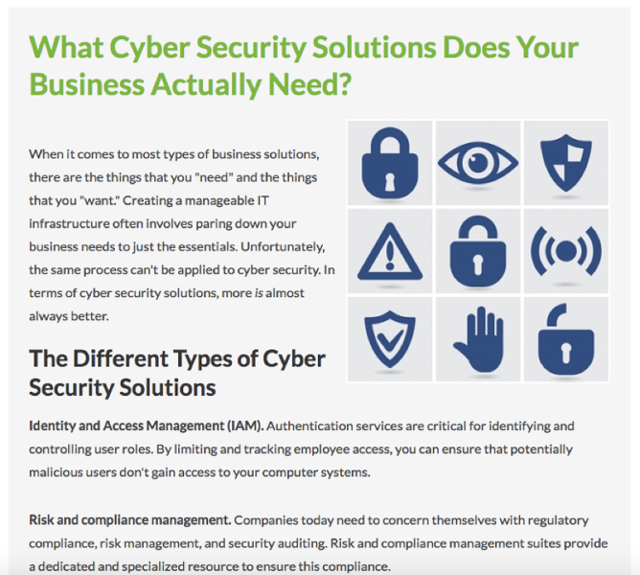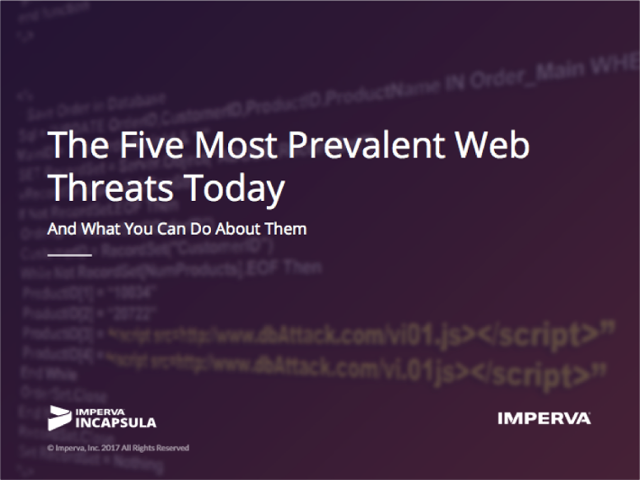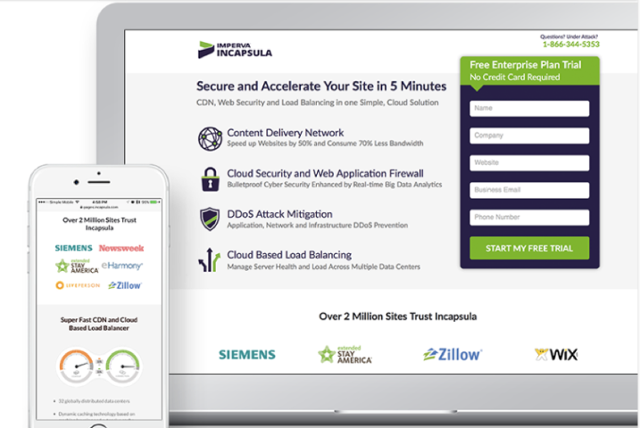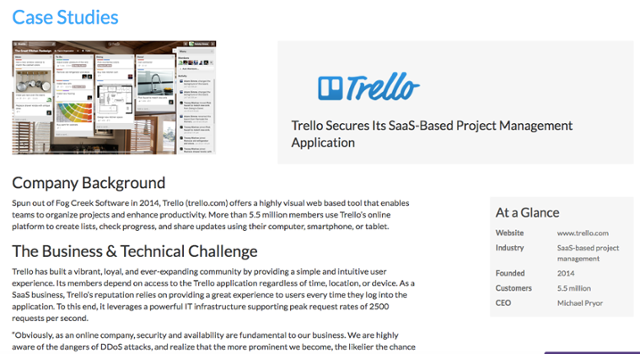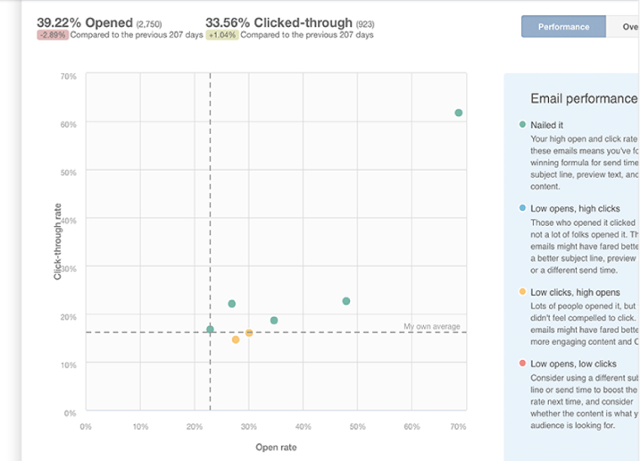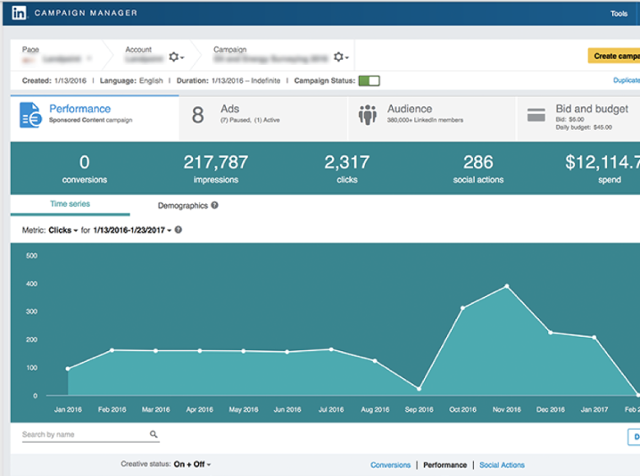
Whether you want to attribute it to the rise of interconnected devices in the IoT revolution or just the growing instances of cybercrime, the cyber security industry has seen immense growth in recent years and shows no signs of stopping. In fact, according to a Cybersecurity Market Report published by Cybersecurity Ventures, worldwide spending on cybersecurity products and services is predicted to surpass $1 trillion from now until 2021. This should come as no surprise given that the average annual cost of cyberattacks worldwide is about $9.5 million, according to Ponemon Institute.
Though there is clearly a need for effective cyber security products and services, there are also many solutions on the market, making it more difficult to capture the attention of your target audience. If your company wants to improve demo sign-ups and drive sales, you’ll need to find ways to make your service stand out in the crowd.
Having worked with cyber security clients, we understand that it can be a challenge to stand out in the crowd and communicate the value of your brand. Over the past few years, we’ve identified a number of tactics that work well for cyber security companies and that ultimately generate demo trials and increase sales.
Below, we’ll discuss why cyber security marketing can be such a challenge and what marketing techniques cyber security organizations can use to improve their reach and conversions.
Why Cyber Security Marketing Can Be a Challenge
Before we get into how exactly to develop cyber security marketing that actually works, let’s look at the challenges that often stand in the way of marketers in this industry. Here are just a few of the roadblocks you may face when trying to get your target audience to sign up for a demo:
There is already a lot of competition out there.
New cyber security companies are popping up all the time in response to the heightened demand. This can make it hard to stand out in the crowd, and it makes it essential for you to communicate what makes your brand different.
Though it’s important to stand out from your competitors, you also want to be credible. Outlandish or over-exaggerated claims may draw a crowd, but, in the end, it is the credible companies that communicate their honest value that will find the greatest long-term success. Unfortunately, it can be difficult to find a balance between standing out while still remaining credible.
Potential customers need a lot of education.
There are a lot of different cyber threats out there, and these threats can change from day to day. As a result, your potential customers need a significant amount of education to understand what threats they face and what solutions they may need.
This is especially true given that CEOs and other C-level executives are not as well versed in information security, which can impact a company’s decision to include cyber security as part of their overall preparedness plan. In fact, according EY’s 19th Global Information Security Survey 2016-2017, almost one-third of information security managers and IT leaders surveyed said that a lack of executive awareness and support was a significant challenge in developing an effective cybersecurity plan for preparedness.
Many businesses just don’t prioritize cyber security.
Though there is plenty of evidence pointing to the necessity of cyber security in protecting valuable data, the truth is that many businesses just don’t prioritize cyber security until it is too late. According to the same Global Information Security Survey mentioned above, only one in five, or 22% of those surveyed said that they fully incorporate information security into their strategy and planning.
This is a surprisingly low percentage given the increase in the number of cyber security attacks in recent years and the average cost of these breaches. Ultimately, this data suggests that cyber security marketers must find ways to create a sense of urgency for potential customers and emphasize the importance of acting pre-emptively.
Which Tactics Should Cyber Security Marketers Use?
That bring us to the big question of how cyber security companies can overcome these challenges and connect with those who need their services. Below, we’ve put together some of the best cyber security marketing tactics to help you drive demo sign-ups and improve overall sales through promoting education and awareness:
1. Content Marketing
Content marketing can help you build credibility while addressing the major challenge of educating your prospects. In order for your content to be effective, it’s essential that your company provides real-world examples to demonstrate both the importance of cyber security and the effectiveness of your solutions.
Not only will your content need to be comprehensive and data-driven, but you’ll also want to ensure that it is unique. Develop educational content that clearly demonstrates how your product solves a real-life cyber security attack and back it up with case studies, independent industry reviews etc. Rather than rehashing the same content that already exists out there, try using new examples or offering a different angle on the types of cyber threats that relate to your specific products and solutions.
When it comes to content marketing, there are a number of different types of content that you can use to reach and engage your audience. Here are a few types of content that can help you reach customers at different points in the buyer’s journey:
Blogs
Blogs are great for attracting prospects in every stage of the buyer’s journey. Try to create some evergreen blog content that will be universally relevant. Topics like “What is a Phishing Attack?” or “What is Mirai-Style DDoS Attack?”are great for customers who are just starting their research and need to learn the basics. For more middle-of-the-funnel leads, topics like “How to Identify Phishing Emails?” or “DDoS Mitigation Best Practices” would work well. Finally, for those prospects that are ready to buy, you can go with a topic like “X Reasons to Choose XYZ Security for Your Anti-Malware Software.”
This is an example of a good TOFU blog post
You should also work to create news-related blog content to attract new leads while building credibility. A topic like “5 Takeaways from Yesterday’s AWS Attack” allows you to benefit from event-related search engine traffic while also taking time to educate your audience. This type of content will help you build credibility and work to be seen as a trusted expert in your industry.
Downloadable Content
Offering downloadable content like e-books and whitepapers is also an excellent way to convert your site traffic into leads that you can later nurture. Not every topic is suited for long-form content, and the truth is that you just won’t have time or resources to create long-form content on every topic. Review analytics for your current content to find the most popular or searched for topics and terms. These are often the best places to start when planning topics for downloadable content.
Downloadable assets like this e-book are a great way to capture TOFU leads
Another aspect of downloadable content that you’ll need to consider is the landing page. Long-form assets like e-books are great candidates for gated content. This will require you to create a tailored landing page that introduces the asset’s topic and provides enough detail for the viewer to determine it is relevant without giving away the good stuff.
With cyber security, landing pages need to quickly and clearly communicate the value of the offer.
Case Studies
According to Content Marketing Institute, case studies are one of the most important tactics for B2B companies. These are excellent for engaging bottom-of-the-funnel leads who already know what their problem is and what solutions will work best.
Case studies like this one are especially helpful for getting buy-in from CEOs and other decision makers.
While composing case studies, make sure that you include plenty of data to show how your cyber security solutions have impacted your client’s bottom line. Providing results like “X number of attacks blocked” or “$X in projected revenue saved” will hit home the need for your solution. Quotes from the client are also helpful as they make the case study more believable and compelling. In addition to a written case study, you might also consider turning your case study into a video for further visual impact.
Video
Explanation videos are another great way to communicate what your cyber security offering does and why it can be valuable to your prospects. This can be an especially helpful tactic when you’re trying to target CEOs and other C-level executives who need more education. According to inbound marketing experts at HubSpot, 75% of executives watch work-related videos on business websites at least once a week, and 59% of executives would rather watch a video than read text. These statistics indicate that executives are open to learning more from video content and may even prefer it over written content.
There are many ways that your company can use video to engage and educate your audience. You might use video content to break down statistics on cyberattacks, recovery expenses, and the value of cyber security solutions. By providing real examples of these issues in your video content, you can help make the statistics more relevant and help create a stronger sense of urgency.
You can also use this visual format to better explain how your solution works and emphasize the value that your company can offer its target audience. As with any offering from a technology company, cyber security solutions can be difficult for those outside of the IT world to understand. However, video content allows you to more easily break down complex ideas for a wider reading audience. This makes it ideal for cyber security companies that need to communicate their value, especially to C-level executives who may need a bit more explanation.
2. Email Marketing
Since education and awareness is a barrier to selling your solution, it can often take a potential lead a significant amount of time to reach the point where they are ready to request a demo or contact a sales representative. In the meantime, you need a way to nurture these leads and move them further down the funnel. Email marketing is an effective way to do just that.
With so many emails in your prospect’s inbox, they may be inclined to delete your email or unsubscribe if they don’t find your content worthwhile. Here are some examples of content that you might include in your email marketing:
- Downloadable content like e-books, case studies, and reports that provide readers with a more in-depth understanding of important cyber security topics.
- Links to your most recent blog posts talking about recent attacks or security concerns and those that break down complex cyber security topics for a wider reading audience.
- Video content that emphasizes the importance of cyber security and communicates the value of your company’s offering.
- A digest of relevant articles from reputable industry publications that helps readers better understand hot topics in cyber security.
- Monthly offers and sales promotions like a free trail, which can encourage prospects to sign up.
Email (along with retargeting ads) are the primary way to nurture leads
Overall, email marketing is an effective way to stay connected to those leads who may not yet be ready to make a purchase. Be sure to regularly monitor your campaigns to see which types of content, subject lines, copy, and images are most effective in regard to open and click-through rates. Also, be cognizant of how many emails you are sending to your prospects. If you flood your prospect’s inbox with emails about the various cyber threats they face, they will become desensitized to them and lose interest.
3. Webinars
Webinars are a great way for cyber security marketers to connect with bottom-of-the-funnel leads. Webinars attendees are already interested in learning more about your solution and the threats it protects against, and they typically have taken some time to do research. This means that they are more likely to be engaged in the topics you are presenting.
One vital part of the webinar is including an interactive element. Webinars typically include a question and answer session at the end of the presentation that offers attendees the opportunity to ask more questions about the topic and your services. This is a valuable opportunity to advertise other helpful content or encourage demo sign-ups. Even if you decide to pre-record your webinar, you can still accept viewer questions and respond in a follow-up.
Webinars can sometimes be costly to produce. However, as with other parts of your marketing campaign, there is also an opportunity to repurpose your webinar to get more out of this content. If the webinar is offered live, be sure to record the content and make this recording available later for those who were unable to attend. If the webinar has a great response then you may also want to consider taking the topics discussed there and creating other types of content like blog posts around these topics. The questions that users ask during the webinar are also an excellent starting point for developing new content that addresses your target audience’s greatest challenges.
In order to promote a webinar and drive attendance, paid channels work well. We have been able to get great results from LinkedIn as well as Google retargeting ads.
Here is a good example of an ad promoting a webinar.
4. Paid Campaigns
Paid campaigns are great at accomplishing two goals – amplifying your content marketing efforts and getting prospects to arrive at your demo request landing page.
First, let’s talk about content marketing amplification. Many marketers feel that paid campaigns and inbound marketing don’t mix, but the truth is that when you combine these two strategies, you end up with a powerful campaign. Say, for example, you just published a study with some pretty compelling data about a particular cyber threat. With this sort of asset, time is of the essence – the older the data is, the less likely prospects will find it useful. By promoting your content through paid channels, you can start to see results more quickly, allowing you to get the most out of the content you’ve created.
LinkedIn is a great paid channel for cyber security.
One of the major goals of any cyber security marketer is getting prospects to request a demo. While getting prospects to this stage takes a little work and a lot of nurturing, paid campaigns can help accelerate the process for those who are ready to make a purchasing decision. You can use paid marketing campaigns to drive more prospects to your demo request landing page. These ads can help ensure that your brand is visible to those who are ready to buy while making your demo readily available to these prospects.
Some cyber security companies may avoid using paid campaigns due to the competitive nature of paid advertising in the cyber security space. That’s understandable – if you don’t know what you’re doing, it’s easy to spend thousands on cyber security ads and get nothing in return. For paid campaigns, you either need a dedicated in-house person (or team) with experience in this area or an agency that specializes in cyber security paid marketing.
Additional Cyber Security Marketing Tips
In addition to using the tactics above, it’s also important to keep a few things in mind about your audience. Though it’s easy to just target CTOs, these are not the only people interested in your solutions. High-ranking IT professionals will likely have a say in which cyber security solution a company decides to go with. However, with the critical nature of data security, the CEO will often be the final decision-maker, and other C-level executives may also be involved in the decision-making process.
Whether you are marketing to the CEO or the CTO, some things remain the same – it is vital that you are honest about your solution’s capabilities and take a data-driven approach to messaging. Use these tips to stay on track:
- Don’t exaggerate your solution’s results. If your cyber security solution only blocks 99% of attacks, don’t say it blocks all attacks. Being honest about your success rate and the capabilities of your solution is the best way to build long-term relationships and drive more positive customer referrals over time.
- Use data in your messaging. Companies who are looking for a cyber security solution need the facts. Use data in your marketing messages to create a sense of urgency and help potential customers better understand the value of your product. In the end, no matter how great your messaging is, the numbers will speak for themselves.
- Create an easy-to-navigate library of premium content. Potential customers need to be able to access your content to educate themselves about cyber security and make a more informed purchasing decision. Make your content easy to access and navigate by building an online library of premium assets.
If you’re not seeing the results you want from your cyber security marketing campaigns, partnering with an agency that specializes in cyber security may be the key to boosting traffic and generating more leads. Want to learn how cyber security experts, Incapsula boosted organic traffic by 107% in just five months after partnering with Seven Atoms? Check out our case study to find out just how we helped transform their lead generation process.
